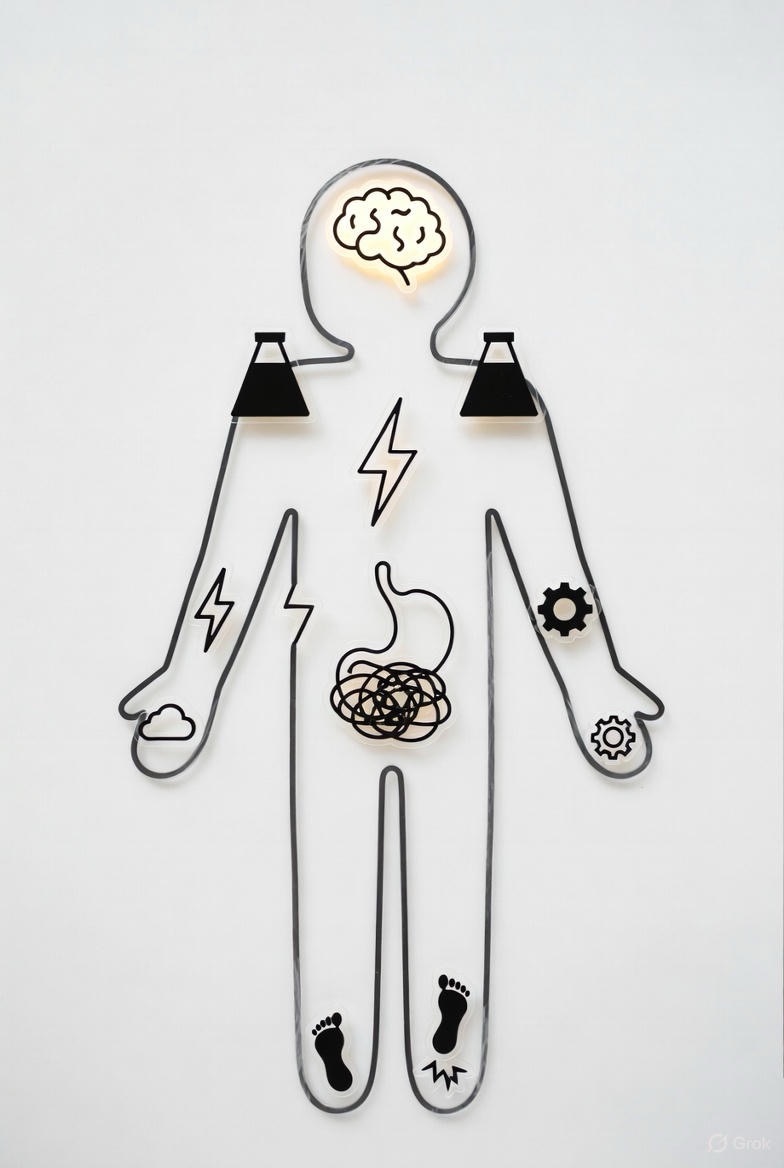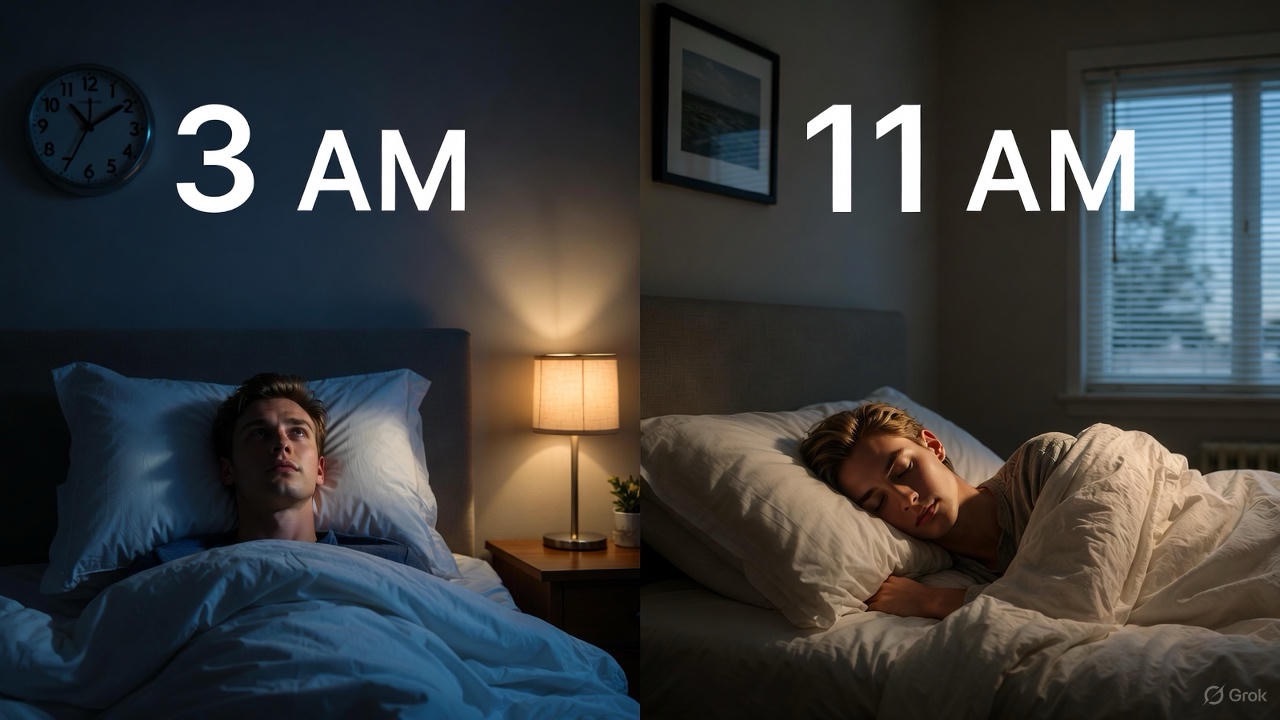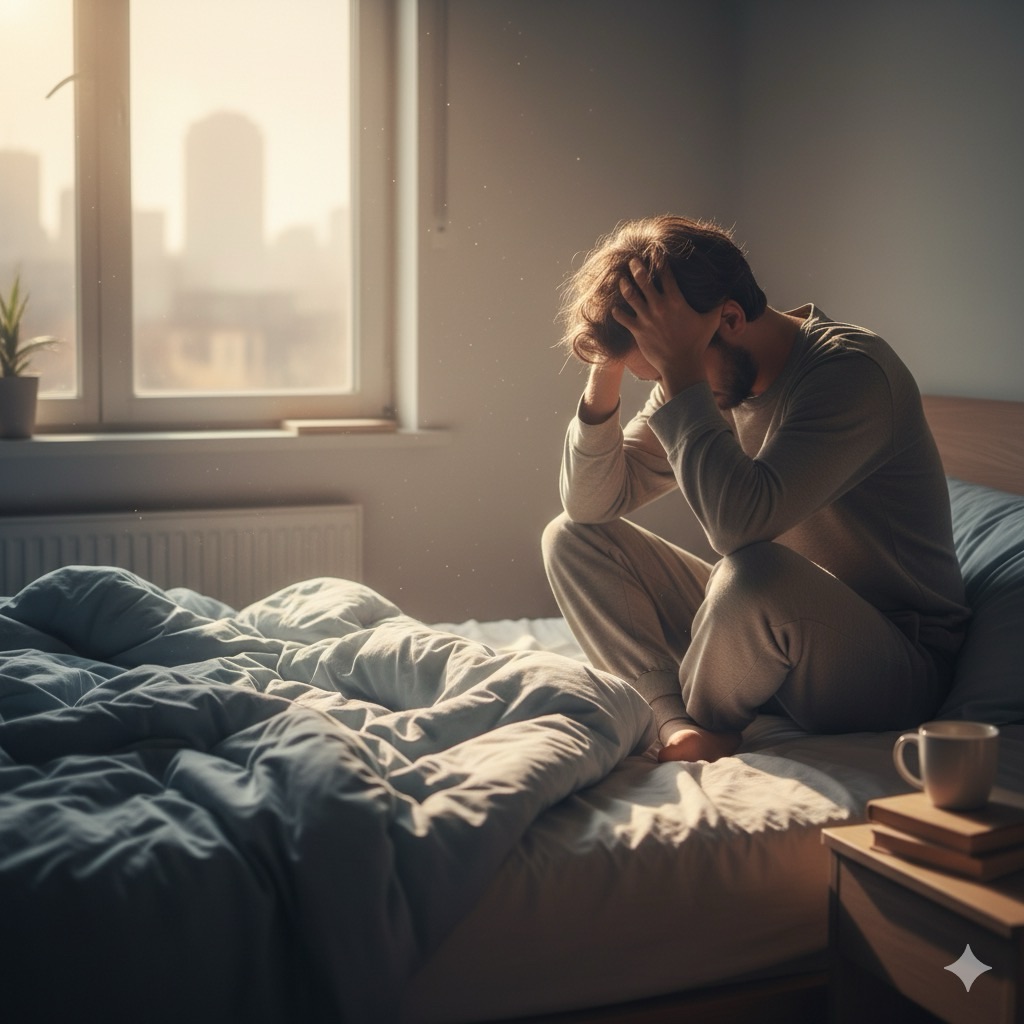When you hear the word “depression,” what comes to mind? Most people think of profound sadness, hopelessness, and a loss of interest in things you once loved.
While these are hallmark emotional symptoms, this picture is incomplete. It misses a crucial, and often more debilitating, part of the illness: the physical symptoms of depression.
The truth is, depression doesn’t just live in your mind; it takes root in your entire body. For many, these physical signs are the first and most persistent clues that something is wrong. Learning to recognize them is vital for understanding your own experience or supporting a loved one.

The Mind-Body Connection: Why Does Depression Hurt?
Depression is far more than a “mood disorder.” It’s a whole-body condition that disrupts key systems. It affects neurotransmitters like serotonin and norepinephrine, which regulate not only mood but also pain, sleep, and energy. It also triggers chronic inflammation and puts your body’s stress-response system, the HPA axis, into constant overdrive. This biological upheaval manifests in ways that are very, very real.
Here are some of the most common physical symptoms of depression:
1. The Bone-Deep Fatigue
This isn’t just feeling tired after a poor night’s sleep. This is a persistent, crushing exhaustion that doesn’t improve with rest. It feels like your limbs are filled with lead, and even small tasks, like taking a shower or making a meal, can feel Herculean. This happens because your body is expending immense energy fighting an internal battle, leaving little in reserve for daily life.
2. The Aches and Pains That Won’t Quit
Unexplained back pain, relentless headaches, sore muscles—these are frequent companions of depression. When your brain’s pain-regulation pathways are disrupted, you can become more sensitive to pain, a condition known as hyperalgesia. Many people visit their doctor for chronic pain, only to discover the root cause is depression.

3. The Sleep Disruption Cycle
Depression and sleep have a toxic relationship. You might experience:
· Insomnia: Lying awake for hours, your mind racing with anxious thoughts.
· Hypersomnia: Sleeping 10, 12, or even 14 hours a night and still waking up exhausted.
This isn’t a choice; it’s a dysregulation of your sleep-wake cycle, robbing you of the restorative rest your body and brain desperately need.
4. The Gut-Wrenching Connection
They don’t call the gut the “second brain” for nothing. Depression can directly cause:
· Appetite changes (a loss of appetite or compulsive overeating)
· Nausea, stomach cramps, and digestive issues
· Significant weight loss or gain
This is due to the intimate link between your gut and your brain, known as the gut-brain axis. When your brain is struggling, your digestive system often feels it first.
5. The “Brain Fog”
You might feel like you’re moving and thinking through a thick fog. This cognitive symptom is profoundly physical in its feeling. It includes:
· Trouble concentrating or remembering things
· Slowed thinking and speech
· Difficulty making decisions
This “flu-like” mental fatigue is a result of how depression impacts cognitive processing speed and executive function in the brain.

6. The Restless Agitation or Slowed Movements
Some people with depression experience psychomotor agitation—a feeling of being physically “wired,” unable to sit still, pacing, or wringing their hands. Others experience psychomotor retardation, where your entire body feels slowed down. Your movements, speech, and reactions can feel like they’re happening in slow motion.
Why Recognizing This Matters
Dismissing depression as “just sadness” is not only inaccurate; it’s dangerous. When people experience these physical symptoms without understanding the cause, they may:
· Feel confused and scared.
· Go from doctor to doctor seeking a purely physical diagnosis.
· Be misdiagnosed or have their suffering dismissed.
· Blame themselves for being “lazy” or “weak.”
Knowing that these symptoms are a recognized part of depression can be incredibly validating. It can be the key that unlocks the right path to treatment.
What You Can Do
If you recognize these physical signs in yourself or a loved one, the most important step is to talk to a professional. Start with your primary care physician to rule out other conditions, but don’t hesitate to see a therapist or psychiatrist.
Effective treatment for depression—whether through therapy, medication, lifestyle changes, or a combination—doesn’t just lift the emotional weight. It can also ease the physical pain, restore your energy, clear the brain fog, and help you sleep again.

Your pain is real. Your exhaustion is valid. By acknowledging the full, physical reality of depression, we can move beyond stigma and toward true healing for the whole person.
If you or someone you know is struggling with depression, please reach out to a mental health professional or a crisis helpline. You are not alone, and help is available.
FAQS
Category 1: Questions of Validation and Relatability
1. “I’ve been feeling this ‘body heaviness’ for months but my blood tests are normal. Could this really be depression?”
· Answer: Absolutely. This is a very common experience. Standard blood tests check for things like thyroid issues or vitamin deficiencies, which can mimic depression, but they cannot measure the complex neurochemical and inflammatory processes of depression itself. The “heaviness” is a real physical manifestation of the condition, not “just in your head.”
2. “I thought I was just lazy or getting sick all the time. Is it possible that my chronic fatigue and aches are actually depression?”
· Answer: Yes, and it’s important to stop blaming yourself. “Laziness” is a choice, while the fatigue of depression is a physiological state you cannot control. When the brain is depleted of certain neurotransmitters, it directly impacts your energy and pain perception systems. What feels like a character flaw is often a chemical one.

Category 2: Questions About Specific Symptoms
1. “Why does depression cause stomach problems like nausea and IBS?”
· Answer: This is due to the powerful gut-brain axis. Your gut and brain are in constant communication via the vagus nerve and neurotransmitters. About 95% of your body’s serotonin (a key neurotransmitter in mood) is actually produced in the gut. When your brain is stressed and inflamed from depression, it disrupts gut function, leading to nausea, cramps, and changes in motility.
2. “What is the difference between just being tired and the fatigue of depression?”
· Answer: Regular tiredness is usually resolved with a good night’s sleep or a relaxing weekend. Depressive fatigue is persistent and unrelenting. It’s a profound exhaustion that isn’t proportional to your activity level and isn’t relieved by rest. It’s often accompanied by a lack of motivation (avolition) that makes it hard to even start an activity that might help.
3. “Is ‘brain fog’ a real medical thing or just a phrase?”
· Answer: It’s a very real and well-documented symptom, often referred to in medicine as cognitive dysfunction. Depression can shrink parts of the brain involved in memory and executive function (like the hippocampus and prefrontal cortex). This physically impacts your ability to think clearly, concentrate, and make decisions.

Category 3: Questions About Action and Next Steps
1. “If I have these physical symptoms, which doctor should I see first: my primary care physician or a psychiatrist?”
· Answer: It’s often best to start with your Primary Care Physician (PCP). They can run necessary tests to rule out other medical conditions (e.g., anemia, thyroid disorders, sleep apnea). Once other causes are ruled out, you can feel more confident that depression is the root cause. Your PCP can then provide a referral to a psychiatrist or therapist, and may even feel comfortable starting initial treatment themselves.

2. “If I get treatment for depression (therapy/medication), will the physical symptoms actually go away?”
· Answer: In most cases, yes. As treatment helps rebalance your brain chemistry and provides coping tools, the physical symptoms often improve significantly, sometimes even before the emotional ones. For example, people often report better sleep and more energy within a few weeks of starting an effective treatment. Treating the depression treats the root cause of these physical issues.
3. “Are there specific things I can do to help the physical symptoms right now?”
· Answer: While not a substitute for professional treatment, these can help manage the symptoms:
· For Fatigue/Brain Fog: Try gentle, manageable movement like a 10-minute walk. It boosts blood flow and endorphins.
· For Aches/Pains: A warm bath or heating pad can soothe sore muscles.
· For Gut Issues: Focus on simple, easy-to-digest foods and stay hydrated.
· For Sleep: Try to maintain a consistent sleep schedule, even on weekends.
Category 4: Questions About Others and Stigma
1. “How can I explain to my family that my back pain and exhaustion are from depression? They just tell me to ‘snap out of it.'”
· Answer: This is incredibly difficult. Try using a medical analogy: “You wouldn’t tell someone with diabetes to just ‘snap out of’ their high blood sugar. Depression is a physical illness of the brain and body. My fatigue and pain are documented symptoms, just like a fever is a symptom of the flu. I am getting the right medical treatment for it.”

2. “Can depression cause physical symptoms even if I don’t feel sad?”
· Answer: Yes, and this is a critical point. This is often seen in what’s called “high-functioning” or “smiling” depression. You might be able to push through your day, but your body is still paying the price. The physical burden—the fatigue, the pain, the brain fog—can be the primary and most honest expression of the illness when the emotional part is being suppressed or denied.

